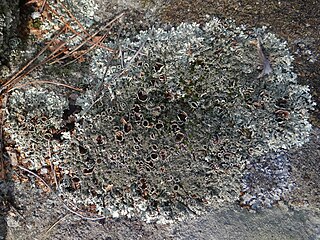
Arctoparmelia is a genus of ring lichens in the family Parmeliaceae. The genus was circumscribed by American lichenologist Mason Hale in 1986 with A. centrifuga as the type species. Hale included five species in his original conception of the genus; the Siberian species A. collatolica was added in 2019.

Bulbothrix is a genus of lichen-forming fungi in the family Parmeliaceae. This genus is synonymous with Bulbothricella V.Marcano, S.Mohali & A.Morales. Bulbothrix was circumscribed by lichenologist Mason E. Hale in 1974 with Bulbothrix semilunata as the type species.

Parmelina is a genus of lichen belonging to the family Parmeliaceae. The genus was circumscribed in 1974 by American lichenologist Mason Hale with Parmelina tiliacea assigned as the type species.

Relicina is a genus of foliose lichens belonging to the large family Parmeliaceae. It contains 59 species. Relicina was originally conceived as a series of the large genus Parmelia by lichenologists Mason Hale and Syo Kurokawa in 1964. A decade later, they promoted it to the status of genus.

Xanthoparmelia is a genus of foliose lichen in the family Parmeliaceae. Xanthoparmelia is synonymous with Almbornia, Neofuscelia, Chondropsis, Namakwa, Paraparmelia, and Xanthomaculina. This genus of lichen is commonly found in the United States, as well as Australia, New Zealand and Ecuador.

Xanthoparmelia mougeotii is a species of foliose lichen belonging to the family Parmeliaceae.
Xanthoparmelia lavicola is a species of lichen in the family Parmeliaceae that can be found in Mexico north to Arizona and California in the United States. It has also been found in Ecuador. Xanthoparmelia lavicola grows in dry habitats on acidic rocks. It has been called the trochanter lichen.

Xanthoparmelia conspersa, commonly known as the peppered rock-shield, is a foliose lichen and the type species of genus Xanthoparmelia. It is widely distributed in temperate zones, and has been recorded from Japan, Europe, Africa, North America, and South America.

Xanthoparmelia mexicana, commonly known as the salted rock-shield, is a foliose lichen in the family Parmeliaceae. It grows in 4–10 cm diameter rosettes of gray-green to yellow-green lobes in arid climates all over the world.

Xanthoparmelia scabrosa, jocularly known as sexy footpath lichen or sexy pavement lichen, is a foliose lichen in the family Parmeliaceae. It tolerates a very wide range of substrata, predominantly rock but also tree bark, roofing tiles, glass, and in wetter areas bitumen paths and roads.

Parmotrema mellissii is a widely distributed species of corticolous lichen in the family Parmeliaceae. It was first described by Carroll William Dodge in 1959 as a species of Parmelia. Mason Hale transferred it to the genus Parmotrema in 1974. The type collection was made in Saint Helena. Parmotrema mellissii has a pale yellowish-buff coloured thallus at least 12 cm (5 in) in diameter, comprising rounded lobes about 15 mm wide and long. It has been found in the southern U.S.A., the Neotropics from Mexico to Colombia and Brazil, Africa, Asia, Australia and Oceania.

Parmotrema zollingeri is a species of lichen in the family Parmeliaceae. It was originally described in 1860 as a species of Parmelia by German lichenologist Johann Adam Philipp Hepp, and named after Swiss botanist Heinrich Zollinger. Mason Hale transferred it to the genus Parmotrema in 1974.
Arctoparmelia separata, commonly known as the rippled ring lichen, is a species of foliose, ring lichen in the family Parmeliaceae with a roughly circumpolar distribution.

Xanthoparmelia lineola, commonly known as the tight rock-shield, is a foliose lichen species in the genus Xanthoparmelia. It is a common species with a temperate distribution. Found in North America and South Africa, it grows on rocks.
Xanthoparmelia elixii is a lichen in the family Parmeliaceae, and found in South Australia.
Xanthoparmelia serusiauxii is a species of foliose lichen in the family Parmeliaceae. Found in Namibia, it was formally described as a new species in 1986 by American lichenologist Mason Hale. The type specimen was collected by Hale from the Laguneberg Mountains, southeast of Cape Cross. There, it is common on dolerite boulders and small, flat pebbles. The specific epithet honours Emmanuël Sérusiaux, who, according to Hale, "was the first lichenologist to collect this unusual lichen in Namibia".
Xanthoparmelia salazinica is a species of lichen in the family Parmeliaceae. Found in South Africa, it was described as a new species in 1989 by American lichenologist Mason Hale. He classified it in Karoowia, a genus that has since been placed in synonymy with Xanthoparmelia following molecular phylogenetic analysis published in 2010.

Parmelina quercina is a species of foliose lichen in the large family Parmeliaceae. It is found in continental Europe.
Xanthoparmelia annexa is a foliose lichen species in the family Parmeliaceae. It was first formally described as a new species in 1964 by Japan lichenologist Syo Kurokawa. After being transferred to genus Paraparmelia in 1986, John Elix transferred it to the genus Xanthoparmelia in 2003 after the two genera were deemed to be synonymous.














